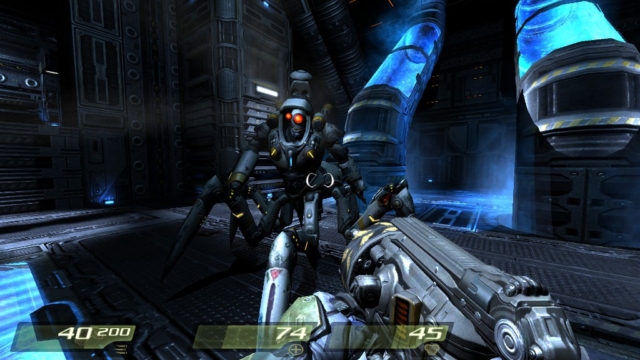
Quake IV
Written by: Stoo
Date posted: January 24, 2014
- Genre: Action
- Developed by: Raven Software, id Software
- Published by: Bethesda Softworks
- Year released: 2005
- Our score: 6
I have an odd relationship with the Quake series. You see, on the one hand I could never summon that much enthusiasm for these games. Nothing much about the first Quake stood out – very standard kind of gameplay for the time and it was all a bit drab, a blur of greens and greys. Quake 2 I can’t remember much more of beyond concrete and smoggy orange skies. As for Quake 3, I don’t do multiplayer much so that was never going to be of interest.
Yet on the other hand, they have their place in my general nostalgia for the shooters of the 90s. It felt necessary to have them in my collection, spread across GOG and Steam, along with the likes of Unreal, Duke3D and Half-Life. Certainly we can’t deny that each one represented a major step forward in graphics; the original was one of the first shooters to be truly 3D, and each sequel came with a new, more advanced engine. Also I’ve always a nagging sense that I’m somehow not doing these games justice. Especially as I played the hell out of Doom and, well, it’s hard to objectively say what about Quake was inferior to that.
It’s probably because of that ambivalence that the fourth game went on my Steam wishlist several years ago but then languished un-purchased. I was finally prompted to spendmoney when I saw it dip under £10 in a sale. Also I realised that, while like the previous Quakes this one runs on an iD graphics engine, the rest of the development work was handled by by Raven. Over the years they had a history of making some pretty great games out of iD engines, often better than iD themselves.
You might recall how the first two Quakes had totally different settings, whereas the third just threw old iD heroes alongside new characters into arenas. This one then follows on from Quake . We return to a future where earth is locked in a war for survival against the Strogg, a race of malevolent cybernetic aliens. Not only are the Strogg relentless and merciless, they create more of themselves by fusing nightmarish technolgy with the bodies of captives and the slain. Which, I must say, is dark and grim on a Warhammer 40k level.
In Quake 2 we saw a desperate attempt to take the fight to the Strogg’s own world, before they could invade our planet. Apparently the hero of that game was able to kill their leader and disable planetary defenses. Now a second wave of attacks is being launched, to finally end the threat from these dreadful abominations. This is where our new protagonist comes in, burly soldier Matthew Kane. He’s en route to the surface with his equally macho squadmates, when their Aliens-style dropship is shot down. Emerging from the wreckage, Kane plunged right into fierce fighting.
Quake 4 is powered by id’s Tech 4 engine (if you’re wondering, Tech 1 is Quake 1), first used for Doom 3. I’m no expert in 3D wizardry so the best I can do is now scurry to Wikipedia. So, erm, apparently one feature is bump mapping, which simulates putting little bumps and wrinkles on an otherwise smooth surface. Also specular highlighting which is… putting shiny spots on an object which gives you idea of position relative to a light source. How clever! Okay, so honestly the metal paneling in these games often gives me the impression of vacuum-formed plastic, but the leap ahead of Quake 3 is undeniable.
As well as sharing tech, this one has some similarities with Doom 3 in terms of aesthetics and design style . Many levels put you in command bunkers, power generation stations and so on. So that means lots of claustrophobic metal corridors and scifi-looking chambers full of machinery of ambiguous purpose. While Doom three went all warped and hellish later on, this one is happy for the most part to stay in those metal rooms, although it does break out it’s own kind of weirdness in the form of fairly horrific cybernetic components. The Strogg after are big fans of harvesting humans for parts, and the sight of a headless, limbless torso wired into pipework and used for something like water filtration is pretty shocking.
Enemies start with fairly standard cyber-guys that make goofy noises and fire off a few desultory shots. Later on new variants are wheeled out that are both more powerful and a bit more disturbing to look at up close, with bits of person wired into large metal chassis. One memorable type hides behind a shield when not shooting at you – so your best bet is to bounce a grenade behind them. Then there are the eerie, floating ghostlike things that teleport around you. Most rage-inducing are the ones that just charge headlong with a melee attack, especially bad when I didn’t have room to maneouver. I tended to just grenade them in the face in a panic and blow myself up in the process.
Regarding your those weapons, you’ll recognise the usual favourites that became associated with Quake series. There’s a nailgun of course, with a nifty homing feature, along with the lightning gun for steadily beaming someone to death and the railgun for sniper work. The obligatory “oh man that’s looks awesome” gun shoots black holes that are appropriately devastating, although their slow speed and the long reload time means it’s tricky to use effectively. Ammo and health packs are scattered around in the usual old-school shooter way, under the semi-believable pretence of supply caches left behind by soldiers.
Maps are very linear, funnelling you from one place to the next. The action then is all pretty straightforward. You find yourself in an enclosed space, assailed by a bunch of monsters. I don’t think the AI is particularly advanced; some go for you headlong, others are content to stomp around a distance away and keep shooting. You dash in and out of cover or circle-strafe until you’ve taken them down. Annoyingly you can’t lean around corners (even tho you see other characters do it!) so the emphasis is more on keeping mobile. Then you’re pushed onto the next set of rooms and shootouts. Occasionally you have some sort of objective like activating a transmitter, but that just means hitting a button at the end of a path somewhere.
Occasionally you’ll hit some sort of scripted event to push the action, like monsters bursting in somewhere unexpected, or friendlies showing up. Also, quite memorably, there’s a good build-up to one of the later bosses. It’s a huge bloated abomination on a jetpack, that makes a few early appearances smashing things up and then flying off, just to make you suitably nervous about having to somehow tackle the thing later on
The presence of your fellow soldiers is a welcome feature. Most obviously they’re useful in a shootout – I don’t know how intelligent exactly, but they provide extra firepower and something else for the monsters to shoot out. Also they won’t get stuck or do anything obviously stupid, so they cover the essentials at least. Also, on a more thematic level, they help give the impression this battle against the strogg is a large-scale military operation, and not just a lone hero single-handedly shooting his way through everything.
Now, Raven had used the idea of regularly fighting alongside friendly squads in Elite Force, several years earlier. Here though it’s less succcessful, and what’s missing is any sense of memorable and likeable characters amongst your allies. The only one who stands out is whiny technician guy; everyone else is pretty much an interchangeable square-headed marine. So you’ll never feel much attachment to them. When someone gets blown away there’s no sense of loss stronger than mild annoyance that you have one less shooter in play. It’s not like I’m expecting development but a bunch of colourful, distinctive characters in the style of Aliens or Predator could have worked very well here.
In between the corridor shooting, on your way to reaching the ultimate mission goal, there are a few key events along the way. A few sections have you controlling vehicles; these are again simple and linear but the variety is appreciated. The map also goes for larger outdoor spaces here, albeit fairly simple roads and courtyards, but also there’s some fairly impressive huge spider-bosses. Meanwhile for a few minutes breather halfway through you get a non-combat sequence aboard the military warship. Most important is a particularly gut-churning sequence of events that, if you haven’t read spoilers, is the one real twist in the plot and may prove quite shocking.
To sum up this game, it’s not particularly particularly ambitious, or original. To give some context, this was a period when Far Cry was throwing us huge gorgeous jungles, and Half-Life 2 gave new interactions with our environment and a great variety of set-piece battles. Quake 4 on the other hand feels like it just took it’s 1997 predecessor, threw in a few developments from around the end of that decade like scripted events and Elite Force style squads, and then settled back for a load of familiar corridor shooting. Apart from brandishing the latest graphics from id, It’s the sort of fare that had been quite familiar for several years, without real steps forward.
I suppose what’s slightly disappointing is that, Raven had shown before that they could take the standard shooter templates of the day, add their own touch and produce something that stood out more from the crowd. As far as this generation of id engines go, I’d actually put id’s own title (Doom 3) ahead of Raven’s, just for its attempts at horror themes. Still, this is certainly a well-made game; I’ve just been assessing it from a rather critical stance. It provided several saturday afternoon’s worth of thrills, some satisfying cyborg-blasting action, and the sort of boss fights that had me swearing at the screen but still invested enough to take another go. It’s also got a bit of eye-catching and chilling imagery.
As I mentioned above, I struggled to find real enthusiasm for the first couple of Quakes. They were however highly rated and very popular, so I realise that my opinions are a bit out of sync with mainstream thought. That’s about the nearest thing we have to controversial content on this site, apart from Rik’s disdain for Sensible Soccer. Looking at this one’s place in history, it seems to have been quite well received, but not regarded as standing out all that much from the competition. So I guess in this instance, my thoughts are more in line with prevailing views: this is a decent shooter, but not a truly great or innovative one.

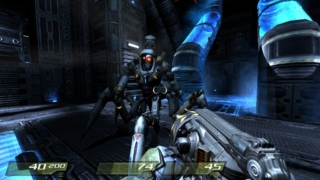
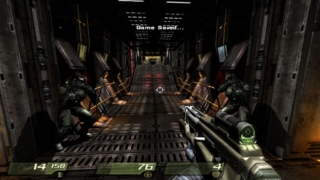
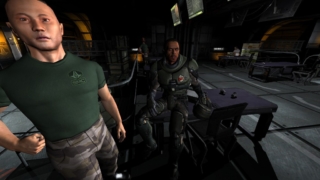
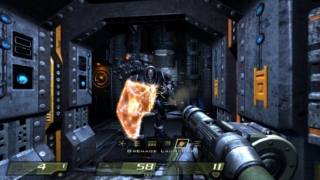

 Posts
Posts
Not one of Raven’s best. When put aside such great games as Jedi Outcast and Jedi Academy and even well-made, but incredibly derivative Singularity, Quake IV pales. Still, not a bad one, a weekend’s worth of shooty-shootiness.
January 27, 2014 @ 3:56 am